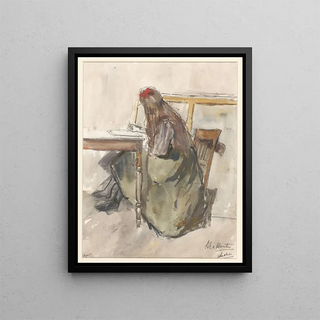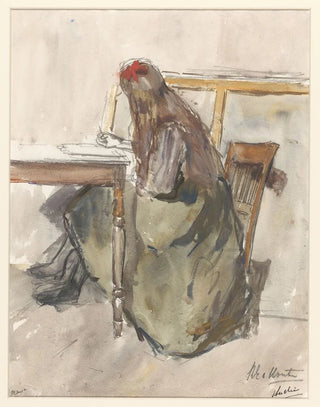Art print Study of a seated girl at a table - Barbara Elisabeth van Houten


View from behind

Frame (optional)
Barbara Elisabeth van Houten’s "Study of a Girl Sitting at a Table" immerses us in an intimate universe where the delicacy of features and the subtlety of colors combine to capture a fleeting moment of everyday life. This painting, both simple and profound, showcases the artist’s mastery in immortalizing emotionally charged moments. The posture of the young girl, her contemplative gaze, and the soft light bathing the scene invite the viewer to silent reflection. This artwork, a true ode to femininity and introspection, encourages us to ponder the thoughts and dreams of this enigmatic figure. By offering a reproduction of this piece, we have the opportunity to rediscover the beauty of the present moment, forever frozen on the canvas.
Style and uniqueness of the work
Barbara Elisabeth van Houten’s style is distinguished by a naturalistic approach, where every detail is carefully observed and rendered with great finesse. In "Study of a Girl Sitting at a Table," the composition is both balanced and dynamic, demonstrating remarkable mastery of proportions and perspectives. The artist skillfully plays with light and shadow, creating a warm atmosphere that envelops the subject. The delicate nuances of the palette, ranging from pastel tones to more intense colors, add an emotional dimension to the scene. This work also stands out for its intimacy, where the depiction of a simple daily activity becomes a pretext to explore universal themes such as solitude, contemplation, and the passage of time. The psychological depth of the character, accentuated by her pensive expression, invites the viewer to personal reflection on their own experiences and feelings.
The artist and her influence
Barbara Elisabeth van Houten, a Dutch artist of the 19th century, established herself in the art world through her unique approach and artistic sensitivity. Influenced by the artistic movements of her time, she integrated elements of realism while developing a style that is uniquely her own. Her work, often focused on female subjects, highlights the condition of women and their place in society. In

Matte finish

View from behind

Frame (optional)
Barbara Elisabeth van Houten’s "Study of a Girl Sitting at a Table" immerses us in an intimate universe where the delicacy of features and the subtlety of colors combine to capture a fleeting moment of everyday life. This painting, both simple and profound, showcases the artist’s mastery in immortalizing emotionally charged moments. The posture of the young girl, her contemplative gaze, and the soft light bathing the scene invite the viewer to silent reflection. This artwork, a true ode to femininity and introspection, encourages us to ponder the thoughts and dreams of this enigmatic figure. By offering a reproduction of this piece, we have the opportunity to rediscover the beauty of the present moment, forever frozen on the canvas.
Style and uniqueness of the work
Barbara Elisabeth van Houten’s style is distinguished by a naturalistic approach, where every detail is carefully observed and rendered with great finesse. In "Study of a Girl Sitting at a Table," the composition is both balanced and dynamic, demonstrating remarkable mastery of proportions and perspectives. The artist skillfully plays with light and shadow, creating a warm atmosphere that envelops the subject. The delicate nuances of the palette, ranging from pastel tones to more intense colors, add an emotional dimension to the scene. This work also stands out for its intimacy, where the depiction of a simple daily activity becomes a pretext to explore universal themes such as solitude, contemplation, and the passage of time. The psychological depth of the character, accentuated by her pensive expression, invites the viewer to personal reflection on their own experiences and feelings.
The artist and her influence
Barbara Elisabeth van Houten, a Dutch artist of the 19th century, established herself in the art world through her unique approach and artistic sensitivity. Influenced by the artistic movements of her time, she integrated elements of realism while developing a style that is uniquely her own. Her work, often focused on female subjects, highlights the condition of women and their place in society. In
12,34 €






